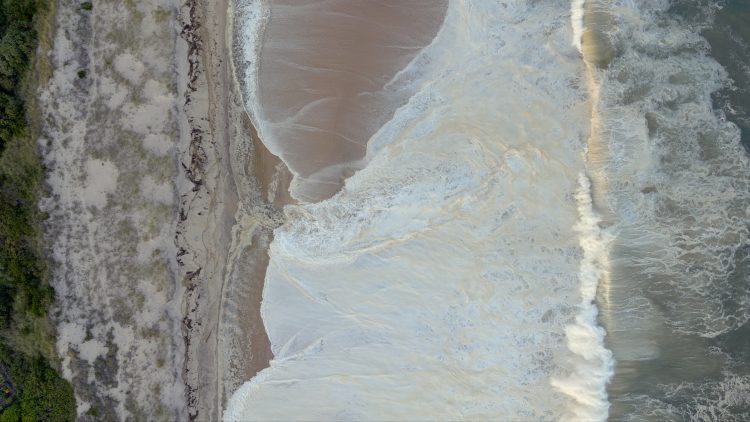Reap the Rewards of Autumn Storms | Fall Run Survival Guide
Autumn storms set the table for striped bass to go on a feeding frenzy before, during, and right after the front’s passage.

The fall run is a chaotic and wonderful time to be a striped bass angler. Even though fishermen throughout most of the Northeast can count on about two solid months of fishing for migrating stripers between Labor Day and New Year’s, there’s a “blink-and-you’ll-miss-it” feel that causes us to cast with a sense of urgency that wasn’t present back when the bass were migrating north. To help make the most of this year’s fall striper migration, we’ve compiled this “Survival Guide” by surveying some of the most dedicated surfcasters in the Northeast and sharing some of our favorite tips for the final months of the striper season. – Jimmy Fee
Most seasoned surf fishermen know that weather systems can turn fishing on or off. Paying attention to the weather can pay great dividends when a storm is on the way and the fishing is set to change.
When looking at the turbulent water stirred up by storms, it’s tough to imagine that fish can see enough to swim and even feed in those conditions. Big bass are built for just such conditions, however. Their broad tails easily handle heavy currents and rough water, and their lateral lines and other sensory organs allow them to locate distressed baitfish, even when visibility is terrible. Bass are also more sensitive to changes in atmospheric pressure than we are. They can sense an upcoming storm long before we fishermen feel its effects.
A few factors play a role in how successful a storm event will be for striper surf fishermen. Fair, stable weather for a number of days before a storm usually sets the table for the bass to go on a feeding frenzy just before, during, and right after the front’s passage. The stable weather allows baitfish to concentrate in large schools, making a feast for the stripers when the rough weather moves through and disorients said baitfish. However, storms tend to scatter bait; many times, by the end of a storm, baitfish will be spread out and striper fishing can be tough.
Surfcasting in a storm can be “combat fishing” at its finest. With large waves, dirty water, and howling winds, finesse fishing goes out the window. Fish the lures that will stand out amid all the commotion, which means large lures, bright colors, and even some sound.
A crucial factor in lure selection during storms is to throw something that will get a striper’s attention and hang in the strike zone long enough to get hit. With large waves and rough water, that can be easier said than done.
If extremely heavy winds don’t make casting them impossible, large swimming plugs are good choices. Those such as the Gibbs Danny, Atom 40, and Atom Junior are great big-water bass catchers. They can be fished successfully in between breaking wave swells, where stripers hound disoriented baitfish.
If the wind makes casting metal-lipped swimmers impossible, you can sacrifice some of the action for casting distance by switching to a bottle-style swimmer or Polaris-style popper. Bottle-style plugs are designed to dig and swim true in even the roughest water. With Polaris-style popping plugs, try dragging them across the top of the water and then pausing them for a brief period of time. A Polaris popper hanging in white water is a deadly imitator of a mullet or other migrating baitfish getting pushed around by the waves.
When using surface plugs in rough water, you will get some of the most spectacular strikes you’ve ever seen. Because a bass knows the bait could quickly disappear in the turbulence, it may throw its entire body at the target, often driving itself completely out of the water.
If plugs aren’t working, you may want to try a bit deeper in the water column by throwing metal lures, bucktails, and plastic swim shads.
Don’t forget about natural baits, either. When the storm passes and the ocean starts to settle, fishing bait on the bottom can result in some very impressive stripers. The heavy seas during a storm often dislodge and crack open clams, crabs, mussels, and other forms of marine invertebrates, making easy pickings for opportunistic bass looking to scrounge up a free meal. Fishing fresh clams on the bottom gives you a great chance at connecting with a large bass. Bunker chunks also work, but keep in mind that clams are the primary bait stripers are after under these conditions.
When trying to decide where to fish during a storm, look for areas where the ocean currents and wave actions are strongest. This usually occurs around irregular structure, especially places that interrupt the general contour of a section of beach. This includes sandbars, sloughs, points, jetties and inlet mouths. In rough conditions, all of these areas draw aggressively feeding stripers from miles around.
My favorite location during the height of a Northeast storm is along the north side of the longest jetty in the area that interrupts an otherwise featureless beach. The wind and pounding waves force baitfish into the pocket formed between the jetty and the beach, and when bass find them, the fishing is incredible. One of the most astonishing sights a surfcaster can see is a blanket of white water in one of these jetty pockets with the greenish-black backs of blitzing stripers tearing through the foam as they feast on baitfish.
My detailed logbook dating back for almost 25 years has revealed a definite pattern to the positive influence storms have on striped bass’ feeding behavior. Some of my largest stripers have come during nasty storm systems, so it pays to get onto the beach even when the weather is doing its best to keep you indoors.
– from the October 2009 Issue of On The Water
Leave a Reply